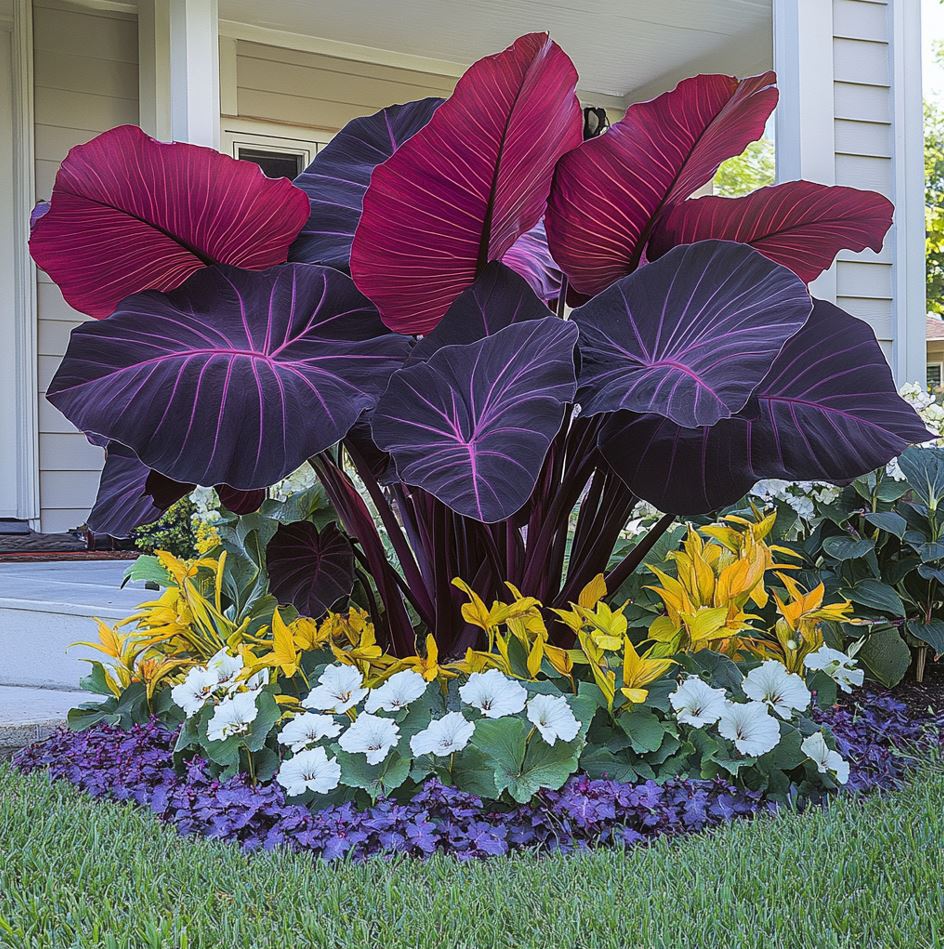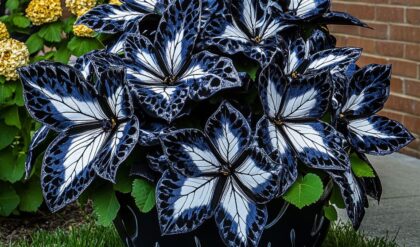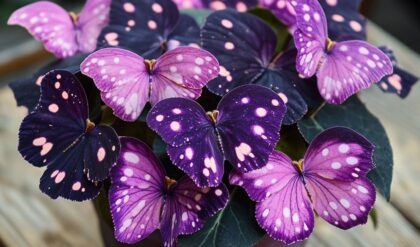Elephant ears, a term that evokes visions of lush tropical landscapes, refers to a captivating group of plants recognized for their striking foliage. Scientifically categorized under Colocasia, Alocasia, and Xanthosoma, these plants are celebrated not only for their aesthetic appeal but also for their unique characteristics that cater to different gardening needs and environments.

Elephant Ears (Colocasia, Alocasia, and Xanthosoma)
Distinguishing the subtle yet significant differences between Colocasia, Alocasia, and Xanthosoma is essential for gardeners and plant enthusiasts alike. At first glance, these plants may seem interchangeable, but each possesses its own distinct personality and characteristics, making them valuable additions to any landscape.
Colocasia: The Gentle Waterfall
Colocasia typically showcases leaves that droop downward with a velvety texture. This characteristic gives it a gentle, cascading appearance reminiscent of a waterfall, perfect for creating a serene atmosphere in gardens or patios. The horizontal spread of Colocasia’s foliage suggests a nurturing embrace, inviting a sense of tranquility and relaxation.
Colocasia’s versatility extends beyond its aesthetic appeal. These plants can provide practical benefits to the ecosystem, offering shade, shelter, and even food, as some species produce edible corms. When incorporated into a water feature, Colocasia can enhance the beauty of the environment and attract diverse wildlife, creating a dynamic interplay between flora and fauna.
Alocasia: The Confident Sculptor
In contrast, Alocasia tends to exhibit more upright foliage, often glossy and shiny. Its leaves can appear almost like elegant sculptures reaching skyward, suggesting confidence and vitality. This vertical stance may reflect an aspirational quality, drawing the eye upwards and encouraging visitors to explore further.
Alocasia’s distinctive features make it an excellent choice as a focal point in ornamental gardens. Its striking appearance can serve as a captivating centerpiece, commanding attention and adding a touch of drama to the overall landscape. However, Alocasia’s care requirements differ from Colocasia, thriving in part shade and well-drained soil, which gardeners must consider when curating their outdoor spaces.
Xanthosoma: The Diverse Visionary
Xanthosoma offers yet another layer of distinction, with broader leaves that can vary significantly in texture and orientation. This visual diversity contributes to the overall richness of plant arrangements, allowing gardeners to create dynamic and captivating compositions.

Xanthosoma’s versatility extends beyond its aesthetic qualities. Some species within this genus are known to produce edible corms, making them a practical addition to the garden. Additionally, the varied leaf textures and orientations of Xanthosoma can serve as a testament to the richness of biodiversity, inviting gardeners to explore the interconnectedness of life forms and the importance of sustainable gardening practices.
The Aesthetic Appeal and Practical Applications
Incorporating elephant ears into landscaping can transform a garden into a tropical paradise. These plants invite a sense of adventure and exploration, evoking images of verdant jungles or exotic retreats. Their bold foliage is not just visually arresting; it contributes practically to the ecosystem, providing shade, shelter, and even food.
When envisioning your outdoor space, consider the roles these plants could play. For instance, using Colocasia as a backdrop in a water feature not only enhances the beauty of the environment but also invites wildlife, creating a dynamic interplay between flora and fauna. Conversely, Alocasia can serve as stunning focal points in an ornamental garden, drawing attention upwards and encouraging visitors to explore further.
Care and Cultivation Considerations
While the allure of elephant ears is undeniable, their care requires understanding the nuances inherent in each type. For example, Alocasia thrives in part shade and requires well-drained soil to flourish, whereas Colocasia often embraces more moisture, making it suitable for boggy areas or near water sources.
This understanding extends beyond mere aesthetics; it reflects a deeper relationship between the gardener and the plants, necessitating a delicate balance of conditions that foster healthy growth. Moreover, recognizing the evolving nature of these plants throughout the seasons could lead to innovative gardening strategies. Imagine implementing seasonal rotations, where certain varieties take center stage at different times of the year, ensuring your garden remains vibrant and engaging all year round.
Alocasia: The Diva of Shade
Alocasia’s preference for part shade and well-drained soil is a critical consideration for gardeners. These plants thrive in environments where they can receive a balance of sunlight and shade, as direct exposure to intense sunlight can scorch their delicate leaves.

To ensure the optimal growth of Alocasia, it’s essential to provide a planting location that offers a mix of dappled sunlight and shaded areas. This can be achieved by positioning the plants near taller plants or structures that offer natural shade, or by strategically placing them in areas that receive morning sun and afternoon shade.
Equally important is the soil quality. Alocasia requires well-drained, nutrient-rich soil to flourish. Amending the soil with organic matter, such as compost or well-rotted manure, can help improve drainage and provide the necessary nutrients for these plants to reach their full potential. Avoid soggy or waterlogged conditions, as they can lead to root rot and other problems.
Colocasia: The Water-Loving Companion
In contrast to Alocasia’s preference for drier conditions, Colocasia often thrives in more moisture-rich environments. These plants are well-suited for planting near water sources, such as ponds, streams, or even in bogs and swampy areas.
The cascading, water-like appearance of Colocasia’s foliage is perfectly complemented by its affinity for moist soil. Gardeners can take advantage of this characteristic by incorporating Colocasia into water features, where its lush leaves can drape over the edges, creating a visually stunning and harmonious integration with the surrounding aquatic environment.
When planting Colocasia, it’s important to ensure that the soil remains consistently moist but not waterlogged. Regular watering or placement in areas with natural water sources can provide the ideal growing conditions for these plants. Additionally, Colocasia may benefit from the addition of nutrient-rich soil amendments, such as compost or slow-release fertilizers, to support their vigorous growth.
Xanthosoma: The Adaptable Visionary
Xanthosoma, with its diverse range of leaf textures and orientations, offers gardeners more flexibility in terms of cultivation requirements. These plants can thrive in a variety of soil conditions, from well-drained to more moisture-retentive, making them a versatile choice for different garden settings.
One of the key advantages of Xanthosoma is its ability to adapt to a wider range of light conditions. While some species may prefer partial shade, others can tolerate more direct sunlight, allowing gardeners to experiment with placements and create visually striking contrasts within their landscape.
To ensure the optimal growth of Xanthosoma, it’s essential to provide well-amended, nutrient-rich soil. Incorporating organic matter, such as compost or aged manure, can enhance soil fertility and water-holding capacity, catering to the diverse needs of the various Xanthosoma species.
Broader Implications of Choosing Elephant Ears
The choice to cultivate elephant ears goes beyond personal preference; it resonates with larger environmental considerations. As we increasingly prioritize sustainable gardening practices, opting for native or adaptive species, understanding the specific needs of Colocasia, Alocasia, and Xanthosoma becomes crucial.
Their varied requirements can inform our choices about water usage, soil management, and the type of wildlife we wish to attract. In essence, selecting these plants is akin to choosing allies in an ecological partnership, inviting resilience and adaptability into the landscape.
By embracing the unique attributes and care needs of each type, gardeners can contribute to a thriving ecosystem that celebrates diversity and promotes sustainability. This approach not only maximizes space but also encapsulates the concept of biodiversity, reminding us of the interconnectedness of life forms.
Conclusion
The captivating world of elephant ears, encompassing Colocasia, Alocasia, and Xanthosoma, offers gardeners a diverse array of options for transforming their outdoor spaces into lush, tropical oases. Each genus possesses its own distinct personality, catering to different aesthetic preferences and practical considerations.
Whether you’re drawn to the cascading grace of Colocasia, the confident elegance of Alocasia, or the adaptable versatility of Xanthosoma, incorporating these plants into your landscape can elevate the overall experience, inviting a sense of adventure and exploration.
Beyond their visual appeal, elephant ears play a vital role in supporting a thriving ecosystem, providing shade, shelter, and even food for various forms of life. By understanding the unique care requirements of each type, gardeners can foster a harmonious relationship between their outdoor spaces and the natural world, contributing to a more sustainable and resilient future.




